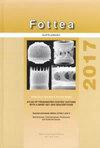推断绿藻系统发育的RNA共有结构:Golenkinia/Jenufa、Sphaeropleales和Volvocales(绿藻门、绿藻科)的三个分类单元分析
IF 1.4
3区 生物学
Q3 PLANT SCIENCES
引用次数: 4
摘要
背景和目的:“请点菜!”是最近发表的一个非常好听和恰当的标题,用于描述绿藻系统发育中一个持续存在的问题。绿藻纲包括两个分支(SV和OCC),由五个目(球形、Volvocales、Oedogoniales、毛藻门和毛藻门)组成。各种数据和方法表明,一个进一步的群体(戈伦基尼+杰努法)不能明确地放在五个目中。此外,关于球孢科和/或Treubarinia,球孢科和volvocia的单系性仍未解决。方法:采用IUPAC (International Union of Pure and Applied Chemistry)编码了Sphaeropleales、Volvocales(含或不含Treubarinia)和Golenkinia+Jenufa组合的不同18S rDNA序列,并组装了相应的18S rDNA共识结构,以独立推断三个分类单元的系统发育关系。利用已知的模板结构,通过同源性建模预测了18S rDNA的二级结构。序列及其单独的二级结构,由12个字母自动编码(每个核苷酸具有三种结构状态,左配对,右配对或未配对),同时对齐;从不同的序列结构比对中读出一致性结构和IUPAC编码的一致性序列。与以往使用18S rDNA数据的研究相比,本研究结果证实了叶绿体数据,并有力地支持了Golenkinia+Jenufa与Sphaeropleales之间的姐妹类群关系。Golenkinia+Jenufa组合与Sphaeropleales(序列-结构一致)有330处匹配,而与Volvocales(序列-结构一致)只有214处匹配。考虑到结构域(I-IV)和高变区(V2-V9),系统发育信息性核苷酸在其结构背景下被突出显示和可视化。在三个分类单元的情况下进行扎根仍然很困难,因为Golenkinia和Jenufa的极长分支被一个选定的外群所吸引,这减少了任何可能的四分类单元树的自举支持,这种支持是通过简约或特征邻居连接分析获得的。结论:对18S rDNA共识数据(IUPAC编码序列和共识结构)与序列组之间的分布距离进行的藻类案例研究表明,系统发育问题可以简化为三分类单元分析。本文章由计算机程序翻译,如有差异,请以英文原文为准。
RNA consensus structures for inferring green algal phylogeny: A three-taxon analysis for Golenkinia/Jenufa, Sphaeropleales and Volvocales (Chlorophyta, Chlorophyceae)
Background and Aims: "Order please!" was a recently published, very nice and apt title for a persistent problem in green algae phylogenetics. The green algal class Chlorophyceae comprises two clades (SV and OCC) made up of five orders (Sphaeropleales, Volvocales, Oedogoniales, Chaetopeltidales and Chaetophorales). A variety of data and methods have shown that one further group (Golenkinia+Jenufa) cannot be unambiguously placed among the five orders. In addition, concerning Sphaeropleaceae and/or Treubarinia the monophyly of Sphaeropleales and Volvocales remain unresolved. Methods: IUPAC (International Union of Pure and Applied Chemistry) encoded consensus sequences for different 18S rDNA data sets as well as corresponding 18S rDNA consensus structures were assembled for Sphaeropleales, Volvocales (with or without Treubarinia) and a Golenkinia+Jenufa assemblage to independently infer phylogenetic relationships in a three-taxon analysis. Using a known template structure, individual 18S rDNA secondary structures were predicted by homology modelling. Sequences and their individual secondary structures, automatically encoded by a 12-letter alphabet (each nucleotide with its three structural states, paired left, paired right, or unpaired), were simultaneously aligned; consensus structures and IUPAC encoded consensus sequences were read out from the different sequence-structure alignments. Key Results: In contrast to previous studies using 18S rDNA data, results of this study corroborate chloroplast data and strongly support a sister group relationship between Golenkinia+Jenufa and the Sphaeropleales. The Golenkinia+Jenufa assemblage shows 330 matches to the Sphaeropleales (sequence-structure consensus) but only 214 matches to the Volvocales (sequence-structure consensus). Phylogenetically informative nucleotides are highlighted and visualized in their structural context taking into account structural domains (I-IV) and hypervariable regions (V2-V9). Rooting the three-taxon scenario remains difficult because the extremely long branches of Golenkinia and Jenufa are attracted to a chosen outgroup, reducing bootstrap support in any conceivable four-taxon tree obtained by parsimony or profile-neighbor-joining analysis. Conclusions: This algal case study of 18S rDNA consensus data (IUPAC encoded sequences and consensus structures) coupled with profile distances between groups of sequences, demonstrated that a phylogenetic problem can be reduced to a three-taxon analysis.
求助全文
通过发布文献求助,成功后即可免费获取论文全文。
去求助
来源期刊

Fottea
生物-植物科学
CiteScore
4.00
自引率
9.10%
发文量
20
审稿时长
>12 weeks
期刊介绍:
Fottea is a journal of Czech Phycological Society (formerly bulletin Czech Phycology). Fottea publishes papers on all aspects of the ecology, physiology, biochemistry, cell biology, molecular biology, systematics and uses of algae (including cyanobacteria)
 求助内容:
求助内容: 应助结果提醒方式:
应助结果提醒方式:


